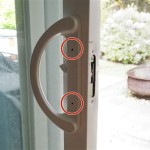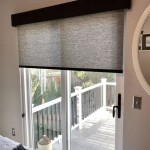Patio Door Kit for Portable Air Conditioner: A Comprehensive Guide
Portable air conditioners offer a flexible solution for cooling individual rooms without the need for permanent installation. However, effectively venting the hot air generated by these units can present a challenge. A patio door kit designed for portable air conditioners provides a specialized solution to this problem, offering a more secure and efficient method of venting compared to simply placing the exhaust hose through a window.
This article will delve into the function, components, benefits, selection criteria, installation process, and maintenance of patio door kits for portable air conditioners. Understanding these aspects is crucial for making an informed decision and maximizing the effectiveness of a portable air conditioning system.
Understanding the Purpose of a Patio Door Kit
The primary function of a patio door kit is to create a sealed connection between the portable air conditioner's exhaust hose and the outdoors, utilizing the existing opening of a patio door. Without a proper seal, the hot air expelled by the air conditioner can re-enter the room, compromising its cooling efficiency and potentially increasing energy consumption. The kit effectively transforms a section of the patio door opening into a secure and adjustable vent for the exhaust hose.
Traditional methods of venting, such as using a window kit, may not be suitable for rooms with patio doors or sliding glass doors. Patio door kits are specifically designed to accommodate the larger opening and horizontal sliding mechanism of these doors, providing a more stable and aesthetically pleasing solution. They maintain the functionality of the door while providing a pathway for hot air exhaust.
Furthermore, a well-designed patio door kit helps to prevent insects and other debris from entering the room. The sealing properties of the kit minimize gaps and openings, contributing to a cleaner and more comfortable indoor environment. Effectively, the patio door kit enhances the overall performance and user experience of a portable air conditioner.
Key Components of a Patio Door Kit
A standard patio door kit typically comprises several essential components, each serving a specific purpose in the installation and operation of the venting system. Understanding these components is essential for both selecting the appropriate kit and ensuring proper installation.
The core of the kit consists of adjustable panels, usually made of PVC or similar durable materials. These panels slide horizontally to fit the height of the patio door opening. The adjustability allows the kit to accommodate a range of door sizes, making it a versatile solution for various installations.
The kit includes a coupler or adapter specifically designed to connect the air conditioner's exhaust hose to the opening in one of the panels. This coupler ensures a secure and airtight connection, preventing air leakage and maximizing the efficiency of the ventilation process. The coupler is often designed to be compatible with standard exhaust hose diameters.
Sealing materials, such as foam strips or weather stripping, are included to further seal the gaps between the panels and the door frame. These materials are crucial for preventing the infiltration of outside air and maintaining the desired indoor temperature. The quality and durability of these sealing materials directly impact the overall effectiveness of the kit.
Additional hardware, such as screws, clips, or adhesive strips, may be included to secure the panels in place. The specific type of hardware will vary depending on the design of the kit and the type of patio door being used. Clear and concise instructions are essential for proper installation using the included hardware.
Advantages of Using a Patio Door Kit
Choosing to use a patio door kit for a portable air conditioner offers several distinct advantages over alternative venting methods. These benefits contribute to improved cooling performance, energy efficiency, and overall user convenience.
Enhanced cooling efficiency is a primary benefit. By creating a tight seal around the exhaust hose and the patio door opening, the kit minimizes the amount of hot air that can re-enter the room. This allows the air conditioner to operate more effectively, maintaining a cooler and more consistent temperature. Reducing air leakage translates to lower energy consumption and reduced electricity bills.
Ease of installation is another significant advantage. Most patio door kits are designed for straightforward installation, requiring minimal tools and technical expertise. Clear instructions and pre-cut panels simplify the process, allowing users to quickly and easily set up the venting system. The installation process is generally non-permanent, allowing for easy removal and reinstallation as needed.
Improved aesthetics and security are also noteworthy benefits. The kit provides a clean and professional appearance compared to makeshift venting solutions. It maintains the functionality of the patio door, allowing it to be opened and closed as needed. The secure fit of the panels also enhances security by preventing unauthorized access through the partially open door.
Finally, patio door kits offer flexibility. They can be adapted to various patio door sizes and configurations. They are also often made of durable, weather-resistant materials, ensuring long-lasting performance and protection against the elements. This adaptability and durability make them a practical and cost-effective solution for venting portable air conditioners.
Factors to Consider When Selecting a Patio Door Kit
Selecting the appropriate patio door kit for a portable air conditioner requires careful consideration of several key factors. Choosing a kit that aligns with specific needs and requirements ensures optimal performance and a hassle-free installation process.
Compatibility with the patio door is paramount. Measure the height of the patio door opening accurately to ensure that the adjustable panels of the kit can accommodate the space. Consider the type of patio door (sliding glass door, French door, etc.) and choose a kit that is specifically designed for that type of door. Review the product specifications carefully to confirm compatibility.
The size and type of exhaust hose are also crucial considerations. Verify the diameter of the air conditioner's exhaust hose and select a kit that includes a coupler or adapter of the corresponding size. Ensure that the adapter provides a secure and airtight connection to prevent air leakage. Consider the length and flexibility of the exhaust hose to ensure that it can reach the patio door opening without undue strain.
Material quality and durability are important factors to consider. Choose a kit made of durable materials, such as PVC or aluminum, that can withstand exposure to sunlight and weather conditions. Look for sealing materials, such as foam strips or weather stripping, that are made of high-quality, weather-resistant materials. A durable kit will provide long-lasting performance and minimize the need for replacements.
Ease of installation and adjustability are also important considerations. Look for a kit that comes with clear and concise instructions and all the necessary hardware for installation. Consider the adjustability of the panels to ensure that the kit can be easily adapted to different patio door sizes and configurations. A user-friendly kit will save time and effort during the installation process.
Step-by-Step Guide to Installing a Patio Door Kit
Proper installation of a patio door kit is essential for achieving optimal cooling efficiency and preventing air leakage. Following a step-by-step guide ensures a secure and effective venting solution.
Begin by measuring the height of the patio door opening. This measurement will determine the required length of the adjustable panels. Ensure that the panels are long enough to completely fill the opening without leaving any gaps.
Next, assemble the adjustable panels according to the manufacturer's instructions. Typically, this involves sliding the panels together and securing them with screws or clips. Adjust the length of the panels to match the measured height of the patio door opening.
Position the assembled panels in the patio door opening. Ensure that the panels are placed securely against the door frame and that there are no gaps. Use the included sealing materials, such as foam strips or weather stripping, to seal any gaps between the panels and the door frame. Pay particular attention to sealing the top and bottom edges of the panels.
Attach the coupler or adapter to the exhaust hose of the air conditioner. Ensure that the connection is secure and airtight. Insert the other end of the coupler or adapter into the opening in one of the panels. Secure the coupler or adapter in place using screws, clips, or adhesive strips, as indicated in the manufacturer's instructions.
Test the installation by turning on the air conditioner and checking for air leakage. If any leaks are detected, use additional sealing materials to fill the gaps. Ensure that the patio door can be opened and closed without obstruction. Make any necessary adjustments to ensure a proper fit and secure installation.
Maintaining a Patio Door Kit for Optimal Performance
Regular maintenance of a patio door kit is essential for ensuring its long-lasting performance and optimal cooling efficiency. Simple maintenance tasks can prevent problems and extend the lifespan of the kit.
Periodically inspect the panels and sealing materials for wear and tear. Check for cracks, gaps, or deteriorated foam strips. Replace any damaged or worn parts as needed. Regularly cleaning the panels and sealing materials prevents dust and dirt buildup, which can compromise their sealing properties.
Ensure that the connection between the exhaust hose and the coupler or adapter remains secure and airtight. Check for loose connections or damaged threads. Tighten any loose connections and replace any damaged parts. Regularly inspect the exhaust hose for kinks or obstructions. Ensure that the hose is properly supported to prevent strain on the connections.
Lubricate moving parts, such as sliding panels or adjustable mechanisms, to ensure smooth operation. Use a silicone-based lubricant to prevent corrosion and maintain smooth movement. Regularly cleaning the area around the patio door kit helps to prevent dirt and debris from accumulating. This will prevent the kit from not sealing properly due to build up.
During periods when the portable air conditioner is not in use, remove the patio door kit and store it in a safe and dry place. This will protect the kit from damage and extend its lifespan. Properly storing the kit along with the air conditioner will help to preserve its integrity for future use.

Custom Balcony Sliding Door Seal For Portable Air Conditioner Exhaust Pipe

Window Seal Universal Kit For Portable Air Conditioner Cloth And Tumble Dryer With Adjustable Coupler Tension Rope 1 Piece 2m

Honeywell Portable Air Conditioners Sliding Glass Door Kit Hl Series

How To Install Portable Ac In A Slide Door Step By Youtube

How To Install Portable Ac In A Slide Door Step By Youtube

Portable Air Conditioner Door Seal For Sliding

Custom Portable Ac Window Kit For Sliding Martinson Manufacturing

Portable Air Conditioner Window Vent Kit Apack5 The Home

Portable Air Conditioner Window Vent Kit Apack5 The Home

Bulk Buy Wholesale Greenfly Jjpro Portable Air Conditioner Window Vent Kit Customized Size Waterproof Door Sealing Seal 3 From Dongguan Far East Ltd Globalsources Com








